| | Agronomic practices that favor crop competition | Diversified production systems | Practices limiting weed spread | Optimal herbicide use
Herbicides continue to be a powerful tool for controlling weeds. However, there is a growing desire to be less dependent on "herbicidal" control of weeds.
Herbicides are viewed as expensive; some weeds have developed resistance to various herbicides, and there is growing public concern regarding the environmental/health effects of pesticides.
Integrated weed management (IWM) is an approach to weed control that attempts to address these concerns. The approach is driven by the need to maximize crop yields and profits while simultaneously protecting natural resources and minimizing environmental effects. IWM strives to be less dependent on herbicides by relying on the combination of many agronomic tactics to control weeds. These tactics include the following:
- practices that favor crop competition
- diversified production systems that make it difficult for weeds to adapt
- practices that limit the spread of weed species
- optimal herbicide use
Agronomic practices that favor crop competition
Seeding shortly after seed bed preparation
Seeding should occur as soon as possible after seed bed preparations are complete to prevent weeds from getting a "head start" on the crop. The earlier weeds emerge relative to the crop, the greater the crop yield loss.
Under a wild oat pressure of 20 plant/m2, yield loss in barley can vary from 17 per cent when wild oats emerge
5 days before the crop to only 3 per cent when wild oats emerge 5 days after the crop (J.T. O'Donovan). Any practice that enables the crop to emerge as early as possible ahead of the weeds will favor crop yield and reduce weed seed production.
Shallow seeding and good "on row" packing
Seeding as shallow as conditions permit is key to rapid emergence. If moisture conditions are good, canola and cereals should not be seeded deeper than a 1/2 inch and 1 inch, respectively. When soils are dry, seeding canola and cereals down 1 and 2 inches, respectively, may prove advantageous.
But seeding deep, particularly into cold soils, will likely delay emergence, increasing the crop's susceptibility to seedling diseases and the effects of herbicide residues. Unfortunately, seeding depth can be quite variable for many openers, especially when the recommended ground speed is exceeded. Information regarding seeding depth control for many openers is available from the Prairie Agricultural Machinery Institute.
Drilling in a crop with good "on row" packing results in better crop establishment compared to broadcast seeding, particularly in a dry spring. On row packing squeezes the soil like a sponge, providing better moisture conditions for crop germination while leaving the soil between the rows loose and less than ideal for germinating weed seeds.
Broadcast seeding of canola may be fast, but it results in variable seeding depth and packing that does not favor crop growth over weeds.
Seeding early
According to Agriculture Financial Services Corporation client records, crops seeded in late April to early May typically produce the greatest yields in Alberta (refer to "Alberta Crop Management Insights" as posted on Alberta Agriculture's "Ropin' the Web" internet site).
Early seeded crops have a yield advantage because they can capitalize on early spring moisture and longer spring days. Also, for canola, early seeding results in less flower blasting since the crop flowers before the hottest part of the summer.
Thus, delaying seeding so that initial flushes of weeds can be controlled is not an effective weed control strategy in conventional systems. The cost in yield by waiting to control a weed flush exceeds the cost of applying an
in-crop herbicide.
Row spacing
Reported effects of row spacing on crop yield and weed management have been variable. However, increasing row spacing in cereal crops and canola from 6 to 12 inches is generally considered to have little effect on crop yield, regardless of tillage regime. Increasing row spacing beyond 12 inches may save on equipment costs and power requirements. However, crop emergence and competitiveness in wider row spacing may be reduced as a result of inter-plant competition and fertilizer burn in single shoot-systems.
Seeding at an optimum rate
The optimum seeding rate is influenced by a multitude of environmental and economic factors. During drought, lower than normal seeding rates may actually increase crop yield by reducing inter-plant competition for soil moisture. When conditions are ideal, higher than normal seeding rates can increase crop competitiveness and yield.
Studies have shown that increasing the normally recommended seeding rate by 50 per cent reduced weed biomass in three of four years in wheat, canola and barley and in two of four years in peas (Table 1). Additionally, these higher crop seed rates gave greater yields in two of four years in canola, barley and peas and in one year in wheat (Table 2).
Table 1. Effect of seeding rate on total weed biomass in barley and
peas at Lacombe and in wheat and canola at Lethbridge from 1998 to 2001.
| . | . | Year |
| Crop | Seed rate (Kg/ha) | 1998 | 1999 | 2000 | 2001 |
| . | g/m2 |
Barley
| 110 | 237 a | 206 a | 228 a | 128 a |
165 | 194 a | 159 b | 127 b | 141 a |
Peas
| 225 | 139 a | 75 a | 21 a | 58 a |
337 | 129 a | 36 b | 19 a | 42 b |
Wheat
| 80 | 83 a | 39 a | 22 a | 14 a |
120 | 94 a | 22 b | 11 b | 6 b |
Canola
| 6 | 93 a | 29 a | 50 a | 53 a |
9 | 80 a | 13 b | 21 b | 27 b |
Table 2. Effect of seeding rate on barley and pea yield at Lacombe and
wheat and canola yield at Lethbridge from 1998 to 2001.
| . | . | Year |
| Crop | Seed rate (Kg/ha) | 1998 | 1999 | 2000 | 2001 |
| . | Kg/ha |
Barley
| 110 | 2638 a | 3314 b | 3234 b | 2184 a |
165 | 2889 a | 3608 a | 3735 a | 2103 a |
Peas
| 225 | 3029 a | 3503 b | 2677 b | 1683 a |
337 | 3231 a | 3869 a | 2999 a | 1666 a |
Wheat
| 80 | 2457 a | 3243 a | 1931 b | 2014 a |
120 | 2544 a | 3063 a | 2307 a | 2016 a |
Canola
| 6 | 1424 a | 1866 a | 1003 b | 764 b |
9 | 1540 a | 2055 a | 1199 a | 985 a |
NOTE: The following information applies to both Table 1 and Table 2.
Horizon and Refine Extra were used in wheat, Roundup in RR canola, Achieve and Prestige in barley and Odyssey in peas.
The results cannot be compared from year to year or from one crop to another. Compare results within the same crop and within the same year. Results in the table followed by the different letters (e.g. a and b) within a crop and year are significantly different at the 5 per cent level.
Source: K.N. Harker, G.W. Clayton, R.E. Blackshaw
In these studies, crop yields were never reduced by raising seeding rates. However, other studies have determined that the optimum seeding rate is also influenced by weed pressure. Figure 1 shows that increasing the seeding rate of barley up to 200 kg/ha can either increase barley yield in the presence of wild oats or decrease it if weeds are absent.
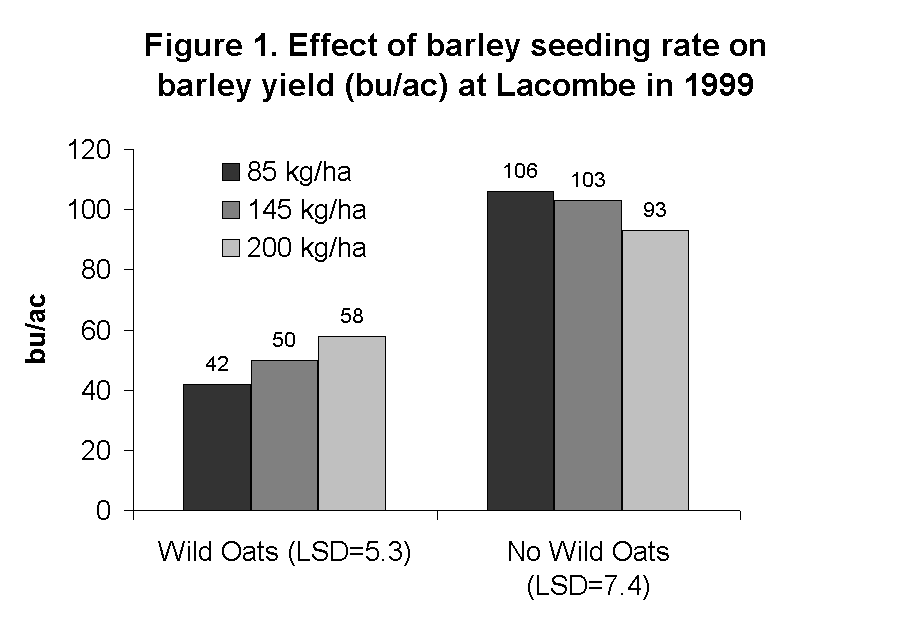
Figure 1. Effect of barley seeding rate on barley yield (bu/ac) at Lacombe in 1999
Source: J.T. O'Donovan, K.N. Harker, G.W. Clayton
The practicality of raising seeding rates obviously depends on seed costs. Increasing the seeding rate of barley to combat weeds is a more cost effective strategy than increasing the seeding rate of a high-cost seed crop like peas.
For barley, a plant population of 200 plants/m2 is generally considered the optimum for weed management and yield. However, survey work in central Alberta found barley plant stands were often well below 150 plants/m2. This result suggests that the competitiveness of barley grown in Alberta could be increased by raising the seeding rate.
To attain a barley plant population of 200 plants/m2 generally requires a seeding rate of about 2 to 2.5 bu/ac depending on variety seed size. However, much higher rates may be warranted depending on environmental conditions.
It is important to note that adequate fertility must be maintained to fully reap the benefits of higher seeding rates. Figure 2 shows that increasing the plant population of barley from 100 to 170 plants/m2 only resulted in higher yield when fertility was adequate. Where the fertility was low, the increase in plant population actually decreased yield.
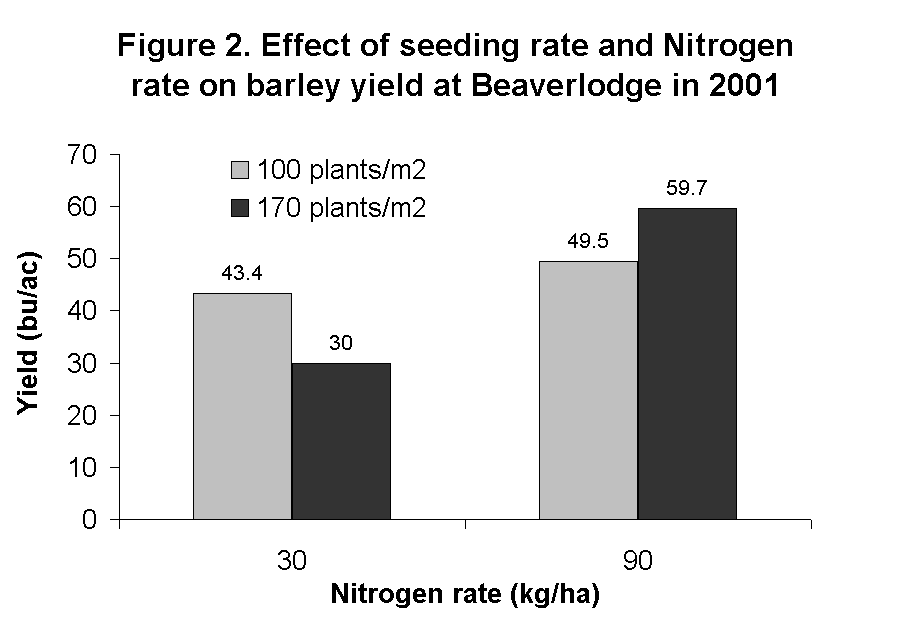
Figure 2. Effect of seeding rate and nitrogen rate on barley yield at Beaverlodge in 2001
Source: J.T. O'Donovan
Choosing an optimum seeding rate for canola can be a little more complicated. The emergence of canola is highly variable compared to other crops. The target plant population for canola is between 40 to 200 plants/m2, which is usually attained by seeding rates ranging from 3 to 8 lbs/ac.
Under ideal conditions, maximum canola yields can be obtained by 40 plants/m2. However, if the field is weedy, higher plant populations are required to maximize crop yield.
One study found increasing canola plant density from 50 to 200 plants m-2 increased the yield of canola in competition with tartary buckwheat by 76 per cent. Furthermore, the production of weed seed was reduced by 64 per cent (Table 3). It should be noted that low canola populations are not only less competitive but run a greater risk of flea beetle damage and delayed maturity.
Table 3. Canola and tartary buckwheat seed yield response to increasing canola seed rates.
| | Canola plants m-2 |
| | Canola yield | T. buckwheat seed |
Tartary buckwheat
plants m-2 | 50 | 200 | 50 | 200 |
kg ha-1 | g m-2 |
| 0 | 1,600 | 1,765 | 0 | 0 |
| 50 | 1,360 | 1,690 | 16 | 4 |
| 100 | 1,170 | 1,610 | 29 | 10 |
| 150 | 980 | 1,550 | 41 | 14 |
| 200 | 895 | 1,505 | 53 | 19 |
| 250 | 800 | 1,410 | 64 | 23 |
Source: J.T. O'Donovan
Vigorous seed and competitive varieties
Planting vigorous seed will help to produce a competitive crop, particularly when conditions for germination and seedling growth are less that ideal (i.e. cold dry soils, fleabeetles, disease, herbicide carry-over). This outcome was demonstrated at Alberta Agriculture's Edmonton Field School by using high rates of seed-placed fertilizer as a "stressor" to inhibit canola germination and emergence.
Figure 3 clearly shows the greater resilience of vigorous seed to high rates of seed-placed fertilizer. Note that once the "stressor" is removed, the stand establishment of high and low vigor seed lots are very similar.
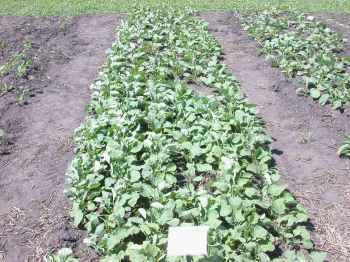 | 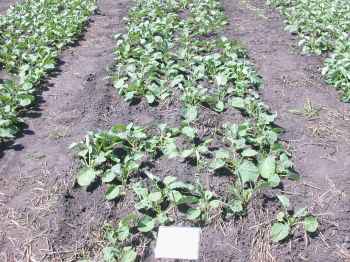 |
High vigor
No seed placed fertilizer
|
High vigor
Seed placed fertilizer
|
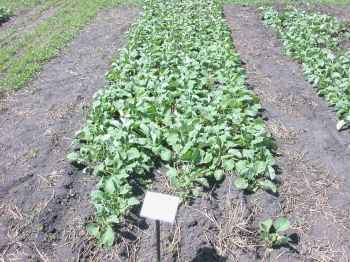 | 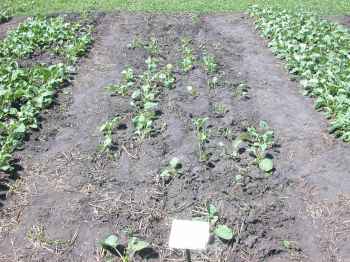 |
Low vigor
No seed placed fertilizer
|
Low vigor
Seed placed fertilizer
|
Figure 3. Impact of a high rate of seed-placed fertilizer on high and low vigor canola seed lots (Edmonton Field School AAFRD 2003)
Several seed labs can provide a seed vigor test, which is an evaluation of how quickly and uniformly a seed lot will germinate under cold, stressful conditions. Simply testing for germination is not enough since the loss of seed vigor precedes the loss of the seed's ability to germinate. Seed vigor can change substantially with time, so tests should be conducted no earlier than three to four months before seeding.
Crop vigor and competitiveness against weeds can differ between varieties. With canola, hybrid varieties are typically more competitive than open pollinated varieties. Figure 4 indicates that weed populations, as evidenced by per cent weed dockage, can be significantly reduced by growing a competitive hybrid such as In Vigor 2153 compared to the open pollinated variety Exceed.
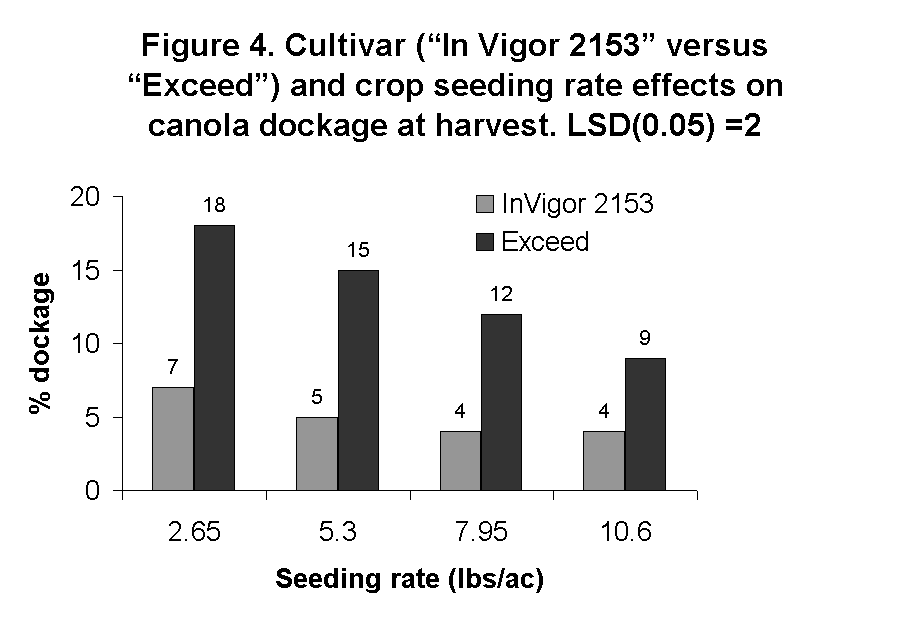
Figure 4. Cultivar ("In Vigor 2153" versus "Exceed") and crop seeding rate effects on canola dockage at harvest.
LSD (0.05) = 2
Source: G.W. Clayton, K.N. Harker
For barley, tall general purpose varieties (e.g. AC Lacombe, Seebee) are more competitive against wild oats than semi-dwarf (e.g. CDC Earl) or semi-dwarf hulless varieties (e.g. Falcon) (Table 4). Poor emergence of Falcon and the shorter stature of Falcon and CDC Earl likely contribute to their relatively poor competitiveness with wild oat. The emergence of hull-less varieties is poor since the bare seed is more vulnerable to mechanical damage and invasion by fungi.
Table 4. Barley yield loss and wild oat seed production in plots with
different barley varieties at Vegreville.
| Variety | Barley yield loss (%) | Wild oat seed m-2 |
| Falcon | 14 | 2380 |
| CDC Earl | 14 | 1380 |
| AC Lacombe | 5 | 800 |
| Seebe | 4 | 720 |
Data represent averages of three barley seeding rates and three site years (1997-1999)
Source: O'Donovan et al. (2000)
Fertilizer placement
Crop competition against weeds is increased when nitrogen is banded instead of broadcast. Banding places the fertilizer where the crop has greater access to it over surface germinating weeds.
Studies from across western Canada have found the yield of wheat in competition with annual grassy weeds can be increased by 12 to 58 per cent when nitrogen is banded instead of broadcast. When nitrogen is banded, the effect of increasing the rate of nitrogen can greatly reduce green foxtail populations, particularly in zero tillage (Table 5).
Under zero tillage, a large proportion of green foxtail seed is confined to the soil surface where germination conditions are less favorable. Recent studies have determined that the yield of wheat in competition with wild oats and wild mustard can often be improved further over mid-row banding by point-injecting nitrogen 10 cm deep at 20 cm intervals every other crop row.
Table 5. Effect of banded nitrogen and tillage on green
foxtail populations at Alliance, Alberta.
Nitrogen rate (kg/ha) | Conventional tillage (emerged m-2) | Zero tillage (emerged m-2) |
0 | 205 | 113 |
60 | 42 | 14 |
120 | 31 | 3 |
180 | 14 | 3 |
Data averaged over 1991 and 1992
Source: O'Donovan et.al (1997)
Removing weeds early
Studies have determined that the yields of pea, canola and cereal crops are maximized when weeds are removed early. With canola, delaying weed removal from 1 to 3 weeks after crop emergence can reduce yield by 5 to 55 per cent, depending on weed pressure and environmental conditions (Figures 5 and 6). To maximize yield, it is now generally recommended that crops be sprayed at the 2 leaf stage for canola, the 2 node stage for peas and the 3 leaf stage for cereals when weed populations warrant control.
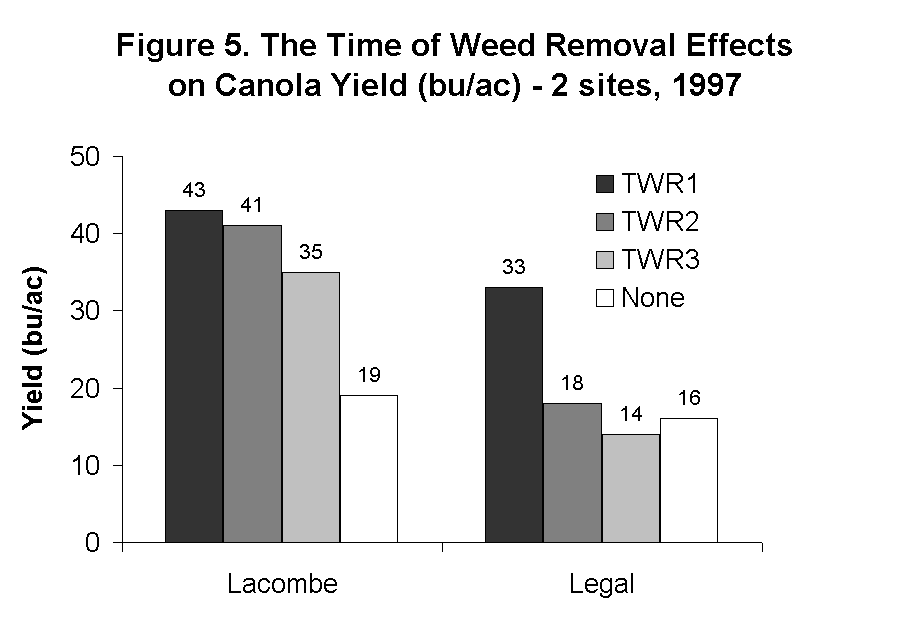
Figure 5. The time of weed removal effect on canola yield (bu/ac) - 2 sites, 1997
(TWR1, TWR2 and TWR3 = 1, 2 and 3 weeks after emergence, respectively)
Source: K.N. Harker, R.E. Blackshaw, G.W. Clayton, J.T. O'Donovan
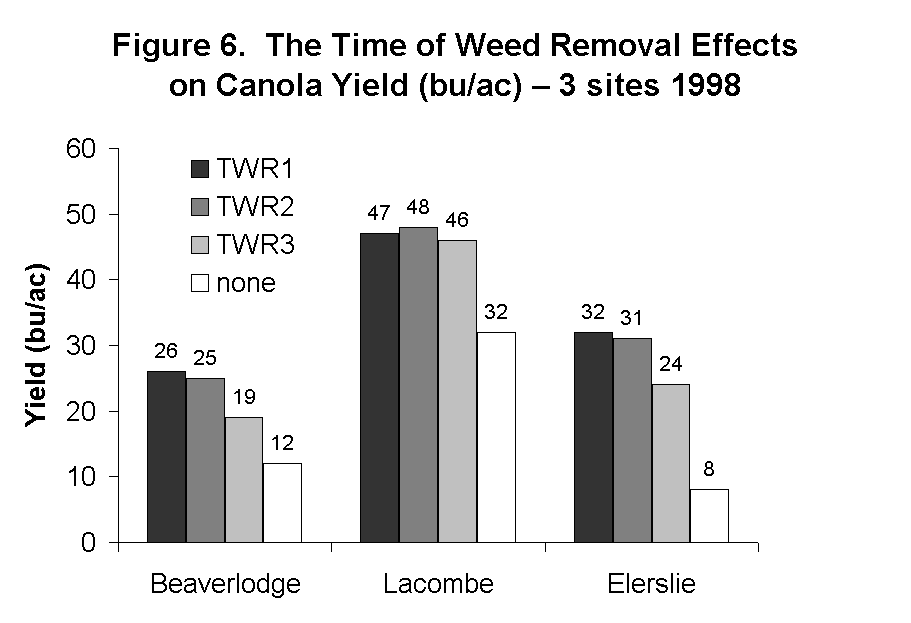
Figure 6. The time of weed removal effect on canola yield (bu/ac) - 3 sites, 1998
(TWR1, TWR2 and TWR3 = 1, 2 and 3 weeks after emergence, respectively)
Source: K.N. Harker, R.E. Blackshaw, C.W. Clayton, J.T. O'Donovan
If spring conditions are dry, early weed removal may not show the greatest yield advantage since the emergence of weeds are delayed. Such was the case at Lacombe in 1998 (Figure 6). If weed emergence is delayed, then spraying should be delayed somewhat. However, the tendency to delay spraying until the majority of weeds have emerged typically results in lower crop yields. Delaying spraying in peas is particularly risky since peas are often sensitive to herbicide injury at the latter growth stages.
Combining agronomic practices
Combining all the agronomic practices that favor crop competition can make the difference between herbicide failure and a bumper crop.
Research from Agriculture and Agri-Food Canada in Lacombe found that canola yield could be increased by 41 per cent just by using a vigorous variety (Invigor 2153 vs Exceed), a high seeding rate (200 vs 100 seeds/m2) and early weed removal (2 vs 6 leaf stage).
At Alberta Agriculture's 2002 Ellerslie field school, the cumulative benefit from proper fertilizer placement, variety choice, seeding rate and time of spraying to canola stand establishment was demonstrated (Figure 7). The input costs for fertilizer and herbicide are identical for the plots in Figure 7, but the crop stands are dramatically different.
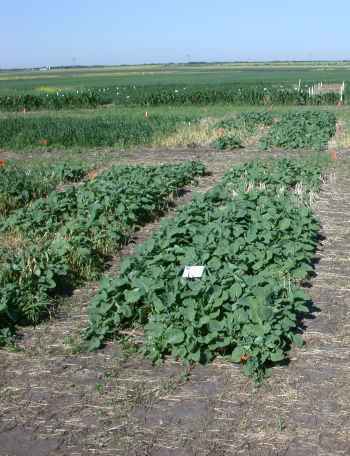 | 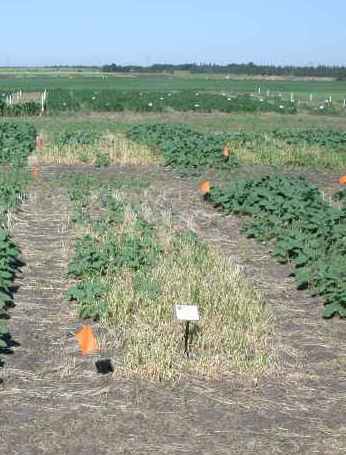 |
Fertilizer: 60 lbs/ac of N side banded; 25 lbs/ac of P205 seed placed
Canola variety: Invigor 2663
Seeding rate: 8 lbs/ac
Time of spraying: Liberta at 2 leaf | Fertilizer: 60 lbs/ac of N; 25 25 lbs/ac of P205 broadcast
Canola variety: Exceed
Seeding rate: 4 lbs/ac
Time of spraying: Liberty at 6 leaf |
Figure 7 (top & bottom). The cumulative effect of fertilizer placement, variety, seeding rate and time of herbicide application on canola stand.
(Integrated Weed Management field school - Elerslie 2002)
Diversified production systems
Production systems that create diversity in cropping patterns, tillage and herbicide use make it difficult for weeds to adapt. Rotating between annual grain crops such as field peas, canola and spring cereals provides an opportunity to rotate between herbicide groups, thereby slowing the development of weed resistance.
Unfortunately, weeds still persist in an annual crop rotation, and the use of herbicides for weed control is heavily relied upon. The weeds persist because they have adapted to the consistent timing of herbicide use, crop emergence and harvest of an annual crop rotation.
Diverse crop rotations that include annual crops, perennial forages, winter cereals and silage crops create variation in cropping patterns (i.e. seeding and harvest dates), making it difficult for weeds to adapt.
Rotations with perennial forages
The inclusion of perennial forage in annual grain rotation reduces weed pressure and the incidence of some problem weeds. Field surveys (just before spraying) from Manitoba and Saskatchewan found the average weed density in cereal crops following cereal crops was 106 plants/m2. By contrast, the average weed density in cereal crops following alfalfa was only 48 plants/m2.
Problem weeds such as wild oats, Canada thistle, wild mustard and cleavers were significantly lower in cereal fields preceded by alfalfa (Table 6). Alfalfa competes well against these weeds because it emerges early, and the harvest timings prevent these weeds from setting seed. By contrast, populations of weeds such as stinkweed and dandelion were found to increase by having alfalfa in rotation. However, it is common practice to keep alfalfa stands too long and then allow them to become "run down" before rotating to cereals.
Table 6. Weed density for cereal following alfalfa (CFA) and
cereal following cereal (CFC) in 1993.
| . | Density (plants/m2) |
| Species common name | CFC | CFA |
| Wild Oats | 27.1 | 1.2 |
| Wild Mustard | 10.6 | 7.9 |
| Canada Thistle | 2.3 | 0.27 |
| Cleavers | 6.4 | 1.5 |
CFC = cereal following cereal
CFA = cereal following alfalfa
Source: P.D. Ominski
Research has shown that optimum rotations should include three years of alfalfa followed by three years of annual cropping, assuming soil erosion is not at risk. The rotational benefits of weed suppression and added nitrogen decline after the alfalfa stand is three-years-old. It is best to remove alfalfa stands in the fall with herbicide instead of tillage (refer to Direct Seeding: Removing Forages from Rotation in a Direct Seeding System. Agdex 519-17).
The use of tillage reduces the yield of succeeding crops by drying out soils and stimulating the germination of annual weeds. Studies have observed the density of green foxtail was 47.5 plants m-2 after an alfalfa stand was removed with tillage compared with only 4.7 plants m-2 where alfalfa was sprayed the previous fall. Similar results where obtained for lambs-quarters in which populations in tilled and untilled plots were 65 and 11 plants m-2, respectively.
A cautionary note, the benefit of incorporating alfalfa into a crop rotation varies depending on soil zone. In the wetter Black and Gray soil zones, grain yields are enhanced when alfalfa or alfalfa/grass mixtures are included in the rotation. However, in the drier Brown and Dark Brown soil zones, forages may reduce soil moisture to the point where the yield of succeeding crops is greatly reduced.
Rotations with winter cereals
Diversifying rotations to include both spring and winter crops has helped producers control weeds. Incorporating winter cereals (i.e. winter wheat, winter triticale or fall rye) into a crop rotation can reduce wild oat pressure and the need for wild oat herbicide. Winter cereals, particularly fall rye, are competitive with wild oats because they emerge long before wild oats. However, if winter cereals are grown continuously, winter annual weeds like downy brome become problematic because of a similar life cycle.
Again, the key to weed control is a diverse crop rotation. By simply incorporating canola into the rotation, producers can keep downy brome populations in check (Table 7).
Table 7. Effect of two cropping sequences on infestation densities of downy brome.
. | Downy bromea |
. | Continuous
winter wheat | Winter
wheat-canola |
| . | plants m-2 |
| 1988 | 30 | 28 |
| 1989 | 54 | 25 |
| 1990 | 190 | 35 |
| 1991 | 400 | 70 |
| 1992 | 920 | 38 |
| 1993 | 740 | 40 |
a Downy brome density recorded in spring before herbicide application
Source: Blackshaw et al. 1994
Rotations with early silaged barley
Before herbicides were available, crops were often silaged early to control wild oats. Recent studies have confirmed that after three years of silaging barley early (after full emergence of barley head), wild oat populations can be substantially reduced compared to silaging at the normal timing (soft dough stage).
In fact, after three years of continuous barley, early silaging without herbicide was more effective in reducing wild oat populations than continuous barley grain production with herbicide (Figure 8). Because of the dormant nature of wild oat seed, a minimum two years of early silaging is required to reduce wild oat populations.
It should be noted that silaging barley early results in a 5 to 10 per cent yield loss. However, this loss may be offset by lower storage losses since the silage is harvested at slightly higher moisture contents.
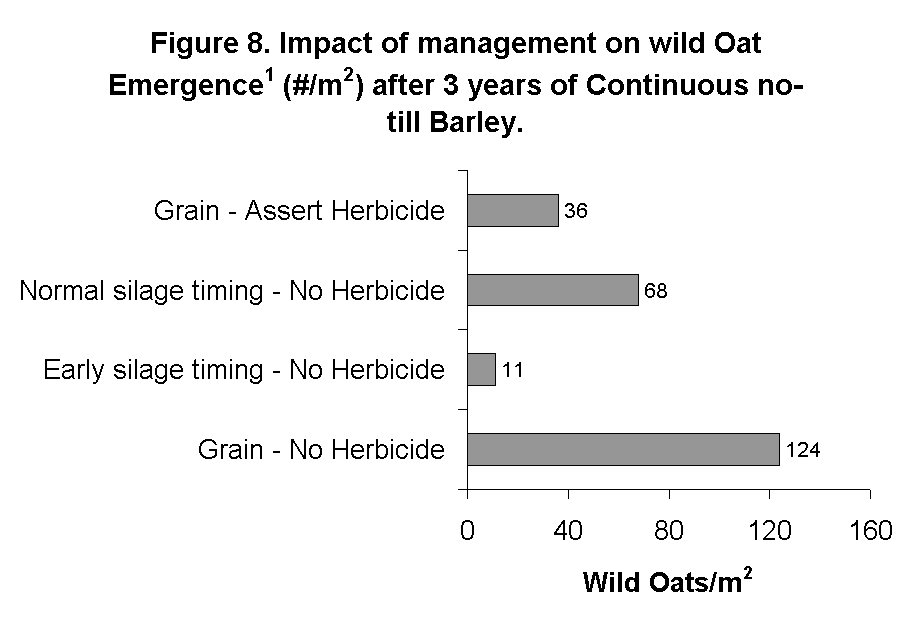
Figure 8. Effect of management on wild oat emergence1 (#/m2) after 3 years of continuous no-till barley.
Source: K.N. Harker, K. Kirkland
1Emergence counts were taken in the spring before the application of herbicide
Tillage
The use of tillage to control weeds can be quite controversial. The adoption of reduced tillage practices has led to reduced costs of production and the conservation and improvement of soil resources. The majority of reduced till farmers would be quite reluctant to use tillage as a means of weed control for fear of losing these benefits.
However, the occasional "strategic" tillage has proved to be an effective means of controlling foxtail barley within a direct seeding system. Control of foxtail barley with glyphosate is sometimes difficult, and tillage is very effective on this shallow-rooted perennial weed. It is likely that most of the soil improvement benefits from conservation farming remain despite the occasional tillage.
Practices limiting weed spread
The easiest and cheapest way to control weeds is to prevent their introduction to the field. This goal can be accomplished a number of ways:
- Asking your dealer for a "Certificate of Seed Analysis." This certificate lists the weed seeds present in that seed lot.
- Cleaning equipment (e.g. combines) before moving to another field.
- Tarping grain loads to prevent weed seeds from blowing out during transport.
- Controlling weeds such as Canada thistle and scentless chamomile in ditches, field edges and around sloughs. Composting manure (one year minimum) to reduce the viability of many weed seeds.
- Monitoring fields. It may be possible to eradicate newly introduced weeds with spot spraying while populations are still low.
- Using chaff wagons to collect weed seed blowing out the back of the combine.
Optimal herbicide use
Herbicides continue to be the most powerful tool for weed control. However, an integrated approach to weed management creates an opportunity to reduce herbicide rates or, in some instances, to forgo the herbicide altogether.
The reduction of herbicide rates is not without risk. There is no recourse with herbicide companies regarding poor herbicide performance if label rates have not been followed. Still, farmers often cut rates as a cost saving strategy.
The effectiveness of a cut rate will depend on the herbicide, weed species present, weed pressure, environmental conditions and, of course, the competitiveness of the crop stand. If weed pressure is high or the weeds are under stress (i.e. drought), it is probably not a good idea to cut back on herbicide rate.
Reducing herbicide rates may be most feasible for wild oat management in barley because of the superior competitiveness of barley, coupled with its relatively low market price and the high cost of wild oat control. Certainly many graminicides (grass herbicides) can be cut back to three quarter rates if the crop stand and environmental conditions are ideal.
In some instances, it may be economical to skip a herbicide application altogether. To determine this option requires field scouting and a knowledge of the "economic weed threshold."
The economic weed threshold is the weed density at which the cost of control is equal to the value of the crop yield lost from weed competition. For example, there is a 60 bu/ac barley crop that is worth $2.5/bu, and the cost of applying a herbicide to control wild oats is $16/ac. In this scenario, the producer can afford to lose 6.4 bu/ac (10.6% yield loss) before the application of the herbicide would be cost effective. Using the following model, producers can determine the economic threshold of wild oats in barley:
Barley yield loss (%) = 1.63 * d / (1 + 0.0163 * d + 0.018 * c)
Where d = wild oat plants m-2, c = barley plants m-2
If there is a crop stand of 200 barley plants/m2, then according to the above formula, there must be at least 32 wild oat plant/m2 before yield loss exceeds 10 per cent and warrants spraying. If there is a crop stand of 150 plants/m2, then only 26 wild oat plant/ m2 need be present to warrant spraying.
Summary
Integrated weed management (IWM) is a sustainable cost-effective approach to weed control that is constantly evolving. The approach combines many agronomic principles to favor crop competitiveness, create diversity in cropping patterns and prevents the introduction of new weed species. Using IWM creates an opportunity to use herbicides more judiciously, increasing economic returns and slowing the development of weed resistance to herbicides.
References
Blackshaw, R.E. 2004. Application method of nitrogen fetilizer affects weed growth and competion with winter wheat. Weed Biology and Management 4(2) 103-113.
Blackshaw, R.E., J. R. Moyer, K. N. Harker. 2002. Integration of cultural practices for sustainable weed management in direct seeding systems. ASEA Final Report Project No. 19980867.
Blackshaw, R. E., J. R. Moyer, R. C. Doram, and A. L. Boswell. 2001b. Yellow sweetclover, green manure, and its residues effectively suppress weeds during fallow. Weed Sci.
...49:406-413.
Blackshaw, R.E., G. Semach, X. Li, J.T. O'Donovan and K.N.Harker 2000. Tillage, fertilizer and glyphosate timing effects on foxtail barley (Hordeum jubatum) management in wheat. Can. J. Plant ...Sci. 80:655-660.
Blackshaw, R.E. 1994. Rotation affects on downy brome (Bromus tectorum ) in winter wheat (Triticum aestivum). Weed Technol. 8:728-732.
Blackshaw, R.E., F.O. Larneyu, C. W. Lindwall, and G. C. Kozub, 1994. Crop rotation and tillage effect on weed populations on the semi-arid Canadian prairies. Weed Technol. 8:231-237.
Carlson, H. L. and J.E. Hill. 1986. Wild oat (Avena fatua) competition with spring wheat: effects of nitrogen fertilization. Weed Sci. 34:29-33
Cousens, R., P. Brain, J.T. O'Donovan and P.A. O'Sullivan 1987. The use of biologically realistic equations to describe the effects of weed density and relative time of emergence on crop yield.
...Weed Sci. 35: 720-725.
Entz, M. H., W. J. Bullied and F. Katepa-Mupondwa. 1995. Rotational benefits of forage crops in Canadian prairie cropping systems. J. Prod. Agric. 8(4): 521-529.
Harker, K.N., G.W. Clayton, R.E. Blackshaw, J.T. O'Donovan and F.C. Stevenson. 2003. Seeding rate, herbicide timing and competitive hybrids contribute to integrated weed management in
...canola (Brassica napus). Can. J. of Plant Sci. 83:433-440.
Harker, K.N., K.J. Kirkland, V.S. Baron and G.W. Clayton. 2003. Early-harvest barley (Hordeum vulgare) silage reduces wild oat (Avena fatua) densities under zero tillage. Weed Technol.
...7:102-110.
Harker, K.N., R.E. Blackshaw and G.W. Clayton. 2001. Timing weed removal in field peas (Pisum sativum). Weed Technol. 15:277-283.
Harker, K.N., G.W. Clayton, T.K. Turkington, J.T. O'Donovan, R.E. Blackshaw and P. Thomas. 2001 "Implementing Weed Management in Canola" In Integrated Weed Management: explore
...the potential ECW(ISBN 0-9688970-0-2) p. 91-98.
Kirkland, K., Holm, F.A and Stevenson, F.C. 2000. Appropriate crop seeding rate when herbicide rate is reduced. Weed Technol. 14:692-698.
Kirkland, K. J. and H.J. Beckie. 1998. Contribution of nitrogen fertilizer placement to weed management in spring wheat (Triticum aestivum). Weed Technol. 12: 507-514.
Lafond, G.P. 1994. Effects of row spacing, seeding rate and nitrogen on yield of barley and wheat under zero-till management. Can. J. Plant Sci. 74: 703-711
May, W.E., G.P. Lafond, E.N. Johnson, T. Hogg, A.M. Johnston, B. Nybo, N. Harker, G. Clayton. 2003. An Assessment of early time of weed removal in field pea using natural weed populations. ...Can. J. of Plant Sci. 83: 423-431.
Moyer, J.R., E.S. Romain, E.W. Lindwall, and R.E. Blackshaw. 1994. Weed management in conservation tillage systems for wheat production in North and South America. Crop Prot. 13:243-258.
O'Donovan, J.T., K.N. Harker, G.W. Clayton, D. Robinson, R.E. Blackshaw and L.M. Hall. 2001 "Implementing Integrated Weed Management in Barley." In Integrated Weed Management:
...explore the potential ECW (ISBN 0-9688970-0-2) p.75-89
O'Donovan, J.T., K.N. Harker, G.W. Clayton and L.M. Hall. 2000. Wild oat (Avena fatua) interference in barley (Hordeum vulgare) is influenced by barley variety and seeding rate.
...Weed Technol. 14:624-629
O'Donovan, J.T., D.W. McAndrew and A.G. Thomas. 1997. Tillage and nitrogen influence weed population dynamics in barley. Weed Technol. 11:502-509.
Ominski, P.D., M.H. Entz and N. Kenkel. 1999. Weed suppression by Medicago sativa in subsequent cereal crops: acomparative survey. Weed sci. 47: 282-290.
Peterson, D.A. and J.D. Nalewaja. 1992. Environment influences green foxtail competition with wheat. Weed Technol.
...6: 607-610
Reinertsen, M.R., V.L. Cochran and L.A. Morrow. 1984. Response of spring wheat to N fertilizer placement, row spacing and wild oat herbicides in a no-till system. Agron. J. 76: 753-756.
Prepared by:
Mike Hall - Integrated Crop Management Specialist; Alberta Agriculture, Food and Rural Development,
Reviewed by:
Robert E. Blackshaw, K. Neil Harker, George W. Clayton and John O'Donovan - Research Scientists; Agriculture and Agri-Food Canada.
Murray Hartman, Rob Dunn - Integrated Crop Management Specialists; Alberta Agriculture, Food and Rural Development
Source: Agdex 642-3. June 2004. |
|